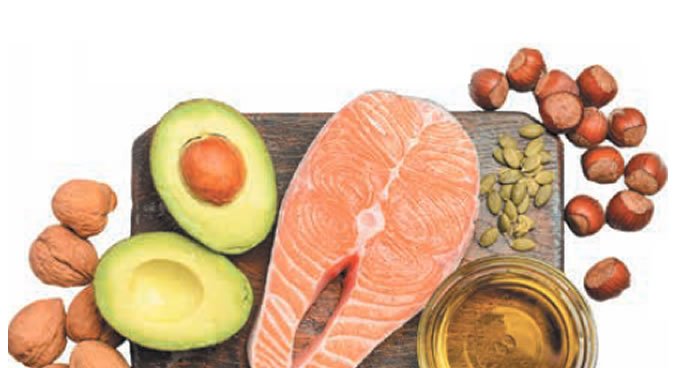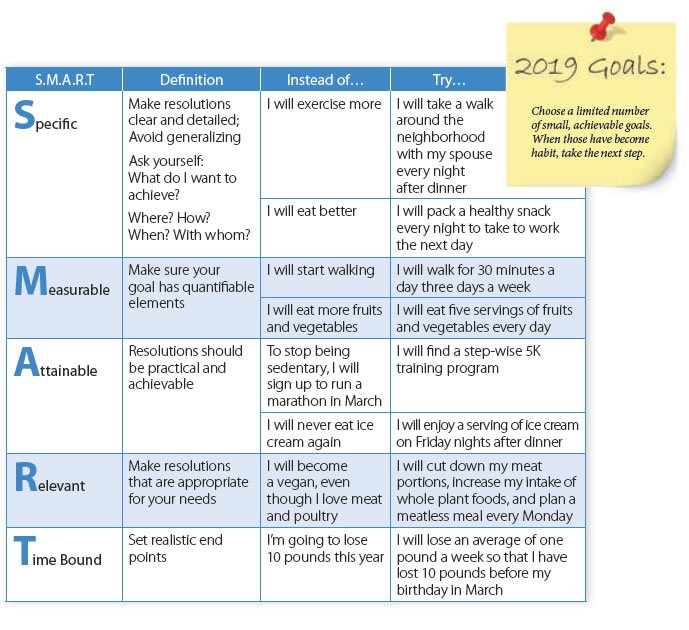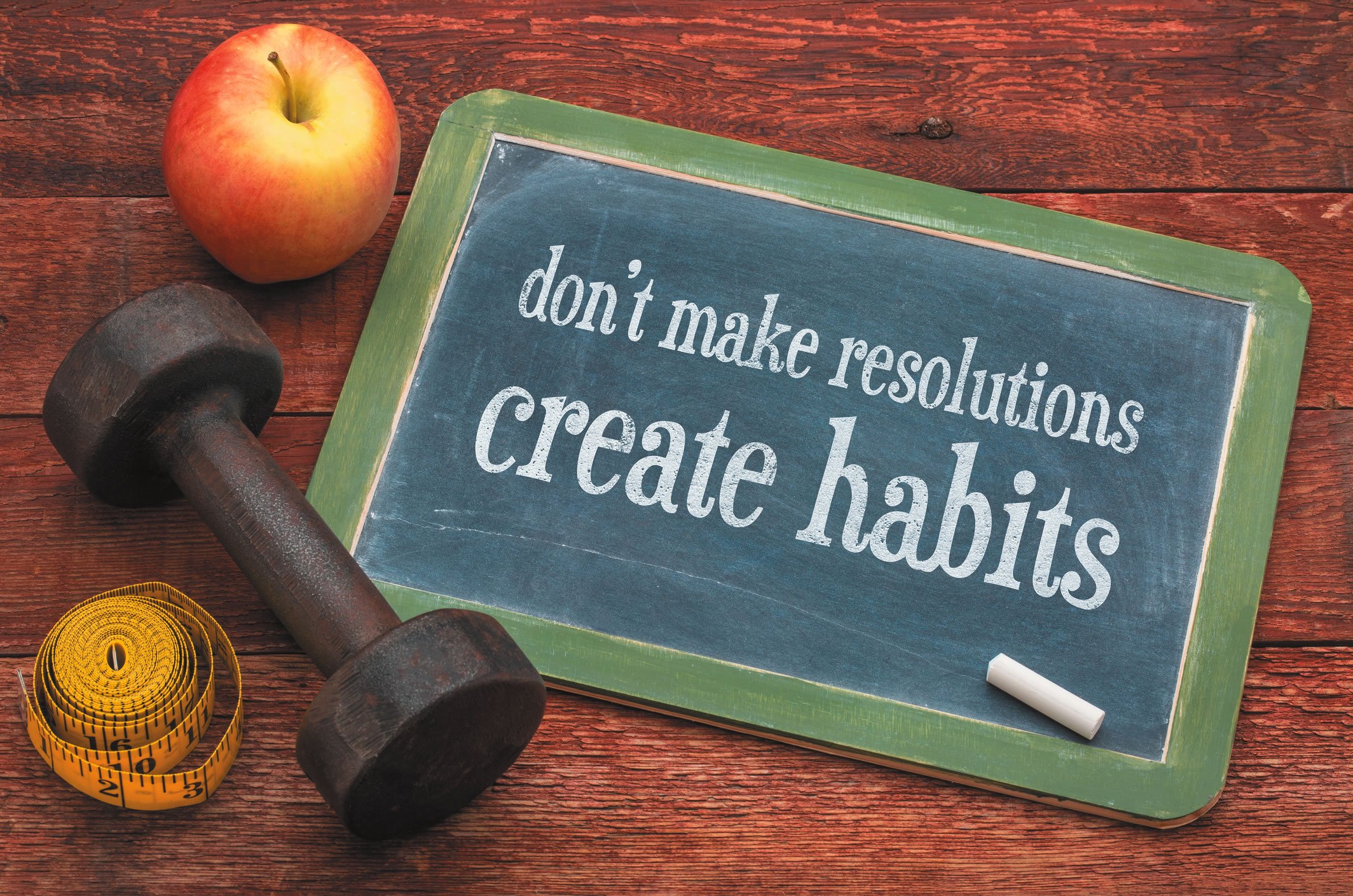Image © alexsl | Getty Images

According to surveys, the two most popular New Year’s resolutions involve losing weight and getting fit—and for good reason. Moving toward a healthier dietary pattern and being more physically active are crucial steps toward achieving well-being—with or without weight loss.
Healthy Eating Goals: Whether your ultimate goal is weight loss; better metabolic health (for example, lower blood pressure, blood cholesterol, or blood sugar); or even reducing your environmental footprint, experts agree that a healthy dietary pattern is the way to go. Cut back on refined grains and starches, high-sodium foods, and sugar-sweetened beverages and other high-sugar foods, and include plenty of fruits, vegetables, nuts, beans, and whole grains, as well as fish/seafood and yogurt in your meals and snacks.
Image © Floortje | Getty Images

Along with physical activity, a healthy dietary pattern is one of the most powerful tools for preventing and lowering risk for chronic diseases such as cardiovascular disease and type 2 diabetes. “If you resolve to change your diet, be realistic,” says Alice H. Lichtenstein, DSc, senior scientist at Tufts’ Human Nutrition Research Center on
Aging and executive editor of Tufts Health & Nutrition Letter. “Set small goals. If you exceed your goal, bask in the glory! For example, consider resolving to cut your consumption of sugar-sweetened beverages (SSB) in half, and if you shift completely away from SSB, all the better. Consider the same approach with whole grains or including more fiber-rich plant foods with meals.”
If having a diet plan to follow motivates you, look for Mediterranean-style or DASH (Dietary Approaches to Stop Hypertension) plans and menus, as there is extensive research supporting the health benefits of both of these dietary patterns. “There are common components to each of these healthy dietary patterns,” says Lichtenstein. “For example, both emphasize fruits, vegetables, whole grains, and lean proteins such as fish and chicken, and individuals can choose any foods from these broad groups. Finding the foods that fit most closely with your own preferences will make it easier to stick to the diet in the long run.”
Weight Loss: If, in addition to improving your dietary pattern, you’re also resolving to lose weight, remember that our bodies change as we age, so it may not be reasonable to aim for that old high school weight or some unlikely ideal. Research indicates that a loss of five to 10 percent of a person’s body weight over a year can have a significant impact on health — about one pound per month for someone weighing 150 to 180 pounds. Beware of crash diets, fads, and plans that exclude major food groups or are overly restrictive, as the majority of research on diets like these has shown that they do not work in the long-run.

It’s not your imagination that weight loss becomes difficult to maintain as time goes on. “The body is attuned to adapt to weight loss by becoming more efficient,” says Sai Das, PhD, a scientist in Tufts’ Human Nutrition Research Center on Aging (HNRCA) Energy Metabolism Laboratory and assistant professor at the Friedman School of Nutrition Science and Policy. “This is important in times of severe energy shortage—such as during a famine—when it makes sense to maintain body functions using less energy. However, this energy economy in today’s food environment means that we may need to work harder to reduce calorie intake in order to sustain healthy weight loss.”
Dariush Mozaffarian, MD, DPH, dean of the Friedman School and editor-in-chief of Tufts Health & Nutrition Letter, recommends against counting calories and cutting out fats: “Focusing on calories alone may lead to long-term failure,” says Mozaffarian. “Additionally, research published in the Journal of the American Medical Association in 2012 suggested that low-fat diets amplify the body’s defense against weight loss, causing large reductions in the body’s energy expenditure, while diets low in refined grains, starches, and sugars protect against this. Eating a healthier diet, including plenty of healthy fats from foods like nuts, avocados, fish, olive oil, and other plant oils, may be one of the best ways to maintain weight loss.”

For weight control, also focus on other aspects of your life, like sleep and time spent watching television. Considerable evidence supports a link between insufficient sleep and weight gain or obesity. According to a 2017 study published in the journal Sleep, not getting enough sleep changes the regulation of hormones that signal hunger and fullness, as well as causing changes in blood sugar regulation. Partial sleep deprivation is associated with increased food intake, changes in hunger and appetite, and cravings for high-calorie “comfort” foods. These findings have been confirmed by MRI imaging of the brain’s reward-center.

According to Mozaffarian, greater TV watching is also strongly linked to obesity at any age, and especially in children. “Evidence from controlled trials suggests that this weight gain is not so much caused by the time spent sitting, but by the snacks and meals eaten while watching TV (when we may be less mindful of cues that we are full). TV ads and marketing have also been shown to lead to less healthy food choices over the course of the day,” says Mozaffarian, “so cut down on TV, or at least avoid snacking or eating while watching, and skip the commercials when possible.”
Research suggests repeatedly losing and re-gaining weight is associated with negative health effects, so make this the year you choose to make permanent changes that lead to slow, steady weight loss. And remember, losing weight, in-and-of-itself, does not guarantee good health. The overall quality of one’s diet is just as important. Choose naturally nutrient-rich foods, whether you’re trying to lose, maintain, or gain weight. “If we cut calories without paying attention to the nutritional quality of the foods we eat, we risk compromising body metabolism and composition,” says Das. “Adopting a healthy, balanced overall dietary pattern will give you the calories you need as well as good nutrition to support health.”
Improving your food choices and physical activity together work in synergy to help achieve and maintain good health and quality of life. Whether weight loss is your goal or not, including physical activity is essential to good health and quality of life.
Exercise Aspirations: According to new data from the Centers for Disease Control and Prevention (CDC), less than 25% of American adults meet the recommendations of at least 150 minutes per week of moderate physical activity (or 75 minutes per week of vigorous physical activity) plus muscle-strengthening exercises two or more times per week. Besides helping with weight control and preserving muscle mass while losing weight, there are many good reasons to resolve to get moving this year. According to the Physical Activity Guidelines Advisory Committee, there is strong evidence that a combination of aerobic and resistance activities is one of the most important things you can do to maintain good health and quality of life as you age, and may:
-Support cardiovascular health
-Maintain muscle
-Improve balance
-Help preserve bones
-Reduce risk of cancer of the esophagus, kidney, bladder, endometrium, lung, and stomach, in addition to breast and colon cancer
-Improve sleep quality
-Reduce risk of clinical depression, as well as reduce symptoms of depression and anxiety
-Improve physical function for individuals of all ages
-Reduce risk of dementia
-Reduce risk of new chronic conditions and/or reduce risk of progression of existing conditions (for example, osteoarthritis and hypertension)
-Reduce risk of excessive weight gain in adults, children, and pregnant women
You don’t have to run marathons to reap health rewards from physical activity. The Advisory Committee report emphasizes that even light-intensity activity, of any duration, can help reduce type 2 diabetes, cardiovascular disease, and mortality. Plus, it’s never too late to start. The LIFE study, led by Tufts researcher Roger A. Fielding, PhD, senior scientist and director of the Nutrition, Exercise Physiology, and Sarcopenia Laboratory at Tufts’ HNRCA, found that older adults who participated in a moderate-intensity walking, resistance exercise, and flexibility program for two years had significantly less disability than a group that received education and stretched. Even adding less than 48 minutes of activity a week had a significant and clinically meaningful impact on outcomes. Additionally, a large study in China concluded that even low levels of leisure-time physical activity lowered risk of type 2 diabetes in adults who already had impaired fasting glucose (although higher levels of activity lowered risk even more).
There is evidence supporting the use of fitness trackers, as well as other technologies like smartphone apps and Internet support groups, to monitor activity levels and provide incentives to be more physically active. Simply writing down what activities you do each day and how long you do them can help, but there are thousands of smartphone fitness apps available for the tech-savvy. These apps offer different capabilities that address different methods of motivation. For example, individuals motivated by goal-setting and progress measurement can download apps that track distance walked or exercise intensity. Those motivated by competition can use apps that rank accomplishments against friends or other online users. For philanthropic-minded individuals, apps are available that convert time spent being active into charitable donations.

Strategies for Behavior Change: If you want to make a lifestyle change, making a resolution is a good place to start. One study found that people who made New Year’s resolutions were more likely to be successful at the six-month mark than non-resolvers. Behavior change is difficult, but research offers tips that may help. In 2010, the American Heart Association (AHA) reviewed multiple behavioral trials and found key actions that support lifestyle change. “Based on our review, we identified simple steps to eating healthier and being more active,” says Mozaffarian, one of the authors of the AHA scientific statement. These steps include:
–Setting specific written targets and goals, with a timeline;
–Tracking your progress in writing or on an app;
–Getting regular, scheduled feedback on your goals, either from your doctor or an app; and
-Setting shared goals with your family or friends, providing peer-support for success
To really impact health and well-being, resolve to make permanent lifestyle changes. “For long-term weight maintenance and optimal body composition, you need to invest in learning new habits—and unlearning ingrained old habits,” says Das. Behavior researchers caution against forcing yourself to do something you hate believing it will eventually become a habit. Instead, work toward life-long change using easy shifts that fit into your existing routine. Studies suggest it may take about 10 weeks of consistently repeating a desired behavior to form a new habit. The more consistently you exercise, avoid stopping at the donut shop, or skip the junk-food aisle in the supermarket the easier it will probably get, and the more likely it is to become second nature.
Even small, incremental improvements in diet and physical activity habits can lead to big health benefits. Whether your New Year’s resolutions are big or small, the experts at Tufts wish you the very best for a healthy and happy year!
Try these tips for making New Year’s resolutions last:
- Set SMART goals. Make New Year’s resolutions Specific, Measurable, Attainable, Relevant, and Time-bound.
- Take small steps. Choose incremental changes that seem do-able to you. For example: someone who habitually drinks soda twice a day may find that cutting back to one soda a day for a few weeks, then switch to flavored seltzer, is easier than quitting “cold turkey.”
- Introduce physical activity slowly. To avoid injury, start with short, less intense activity sessions and gradually increase intensity and duration.
- Plan. Put time to be physically active on your calendar; shop ahead to have ingredients for healthy meals and snacks on hand; try cooking ahead and freezing so healthy choices are available when time and energy are short; and avoid buying those foods and beverages you have resolved to cut down on.
- Track your progress. Use a notebook, fitness tracker, or smartphone app to monitor your dietary intake and/or physical activity progress.
- Team up. Find a friend or online community to help with accountability and commitment. Something as simple as sending each other daily “did you exercise today” texts can be effective.
- Make it fun. No one is going to stick with something they hate. Find an activity that gets you moving and brings you joy. Take a healthy-cooking class, cook with family or friends, or experiment with new foods to make eating enjoyable.
- Cheer yourself on. Celebrate each little achievement. Throwing your fist in the air, patting yourself on the back, or literally saying, “good job” out loud may create an association between the new behavior and positive feelings.
More information, recipe ideas, and meal planning tips can be found at the following Web sites:
National Institutes of Health, DASH Eating Plan: www.nhlbi.nih.gov/health-topics/dash-eating-plan
Oldways: Mediterranean Diet: oldwayspt.org/traditional-diets/mediterranean-diet





















